|
|
Despite Yongmei's transistor tooter age is over (see Golden Camel 7A), they still make the definitely worst built keyboards I ever saw! While the case design and operation of this fullsize tablehooter from 2004 (printed PCB date) almost perfectly matches modern sound bank keyboards, the case is of wacky plastic, it stank badly of acrid chemicals and makes some polyphony flaws by omitted key matrix diodes. The instrument also has only 10 instead of pretended 100 preset rhythms because the rest is simply identical to fraud customers. Also some sounds are identical. The keyboard percussion mode has only 10 sounds despite 54 icons. But at least the percussion has a special timbre and the main voice has a warm analogue home organ appeal with lovely grungy distortion that sounds quite unique.
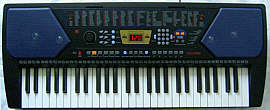 |
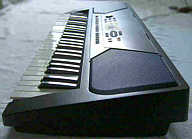 |
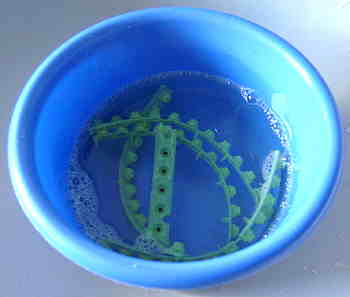 When
new, this thing stank so horrible of toxic chemicals (styrol, phthalate,
organic solvents, formaldehyde?) that I got headache and a sore throat
whenever I played it for longer than 5 minutes. The internal pseudo- rubber
contacts are made soft PVC that stank very badly. To reduce that odour,
I took these parts out and washed them many times in boiling hot soap water
(which left oily phthalate residues in the bowl). After that I had to vent
out the keyboard in the bathroom for 6 weeks(!) to reduce the remaining
odour to a bearable level, but it still smells a little. With my specimen
initially some keys got stuck due to badly deburred plastic rims, and others
worked badly because the PVC contact strip was badly mounted by sloppy
sweatshop labour. Annoying is that by omitted key matrix diodes some polyphonic
note combinations play wrong additional notes or cancel out others, although
here the flaw is way less severe than with other keyboards (see e.g. Yongmei
DL-2300) since it only occurs when keys are pressed hard. Unfortunately
also the user interface has severe flaws those disturb live play. When
new, this thing stank so horrible of toxic chemicals (styrol, phthalate,
organic solvents, formaldehyde?) that I got headache and a sore throat
whenever I played it for longer than 5 minutes. The internal pseudo- rubber
contacts are made soft PVC that stank very badly. To reduce that odour,
I took these parts out and washed them many times in boiling hot soap water
(which left oily phthalate residues in the bowl). After that I had to vent
out the keyboard in the bathroom for 6 weeks(!) to reduce the remaining
odour to a bearable level, but it still smells a little. With my specimen
initially some keys got stuck due to badly deburred plastic rims, and others
worked badly because the PVC contact strip was badly mounted by sloppy
sweatshop labour. Annoying is that by omitted key matrix diodes some polyphonic
note combinations play wrong additional notes or cancel out others, although
here the flaw is way less severe than with other keyboards (see e.g. Yongmei
DL-2300) since it only occurs when keys are pressed hard. Unfortunately
also the user interface has severe flaws those disturb live play. |
I also really don't understand why Yongmei decided to annoy their customer with fake duplicate preset sounds and rhythms to pretend a modern 100 sound bank; even when in the cheap single chip CPU there was really too little memory left to store more samples or 100 individually programmed presets, they should at least have filled the rest with algorithmically generated variants of the given sounds or rhythms. The older(?) Yongmei YM-2100 did this without problem, which was much more honest and useful.
All preset sounds beside "Acoustic Grand Piano" (which is a sample) are made from static natural waveforms with simple volume envelope. Most are not realistic, but they have a nicely warm home organ or C64 appeal and many resemble filtered squarewave. Because polyphonic notes add a dose of analogue distortion, especially organ and e-piano sounds turn into a nicely freaky rock organ timbre. In Germany we call that kind of distorting electronic organ a "Schweineorgel" (i.e. "pigs organ"), although the keys here are too wacky to compete with a robust Hammond organ waterfall keyboard. Beside sustain and vibrato there is also a so-called "echo" effect, which retriggers the note like a slow mandolin ring so long a note is held. The percussion is made from medium low resolution samples; hissing timbres have an special rough and impulsive appeal that reminds to POKEY noises - they somewhat resemble the famous woody knocking Casio sample percussion, although the timbre is different. The accompaniments of the 10 preset rhythms unfortunately only accept standard establishment chords; at least the piano bass lines grunt nicely and the "samba" style grooves good. There is also a poorly working programmable rhythm pattern (not combinable with accompaniment) and a simple metronome. The thing has also 5 lovely demo melodies (4 of them Chinese) with teaching function. Despite stereo sound the speaker jack is only mono.
Like with Sankai 01870K, the manual contains schematics, those still show the keyboard matrix diodes those were omitted in my version. Also a silver version of the Yongmei YM-3300 was made.
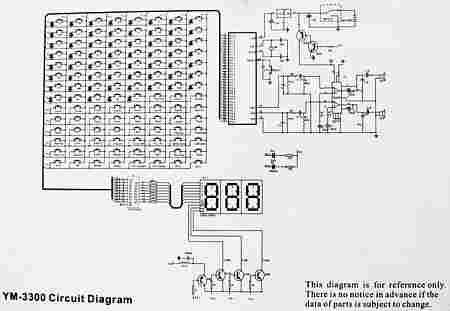 |
 |
 |
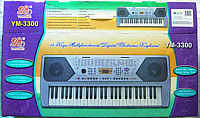 |
 |
 |
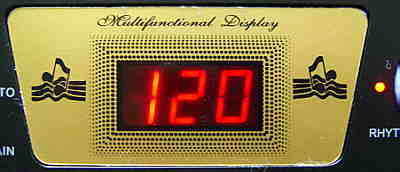 |
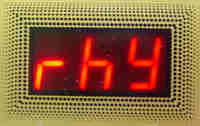 |
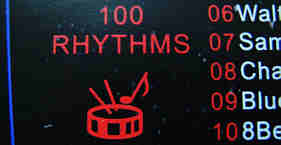 |
 |
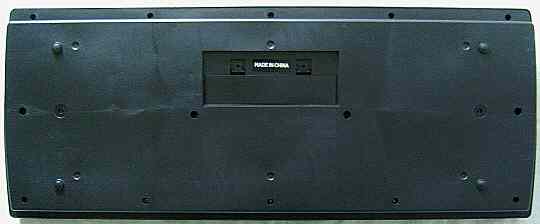
|
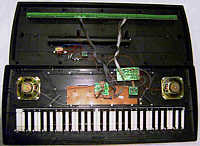 |
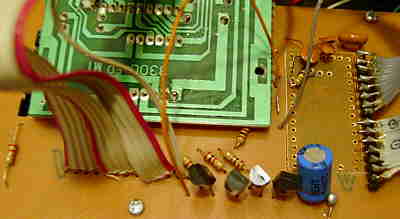 |
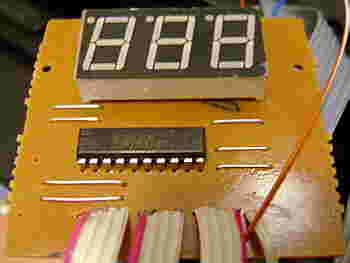 |
 |
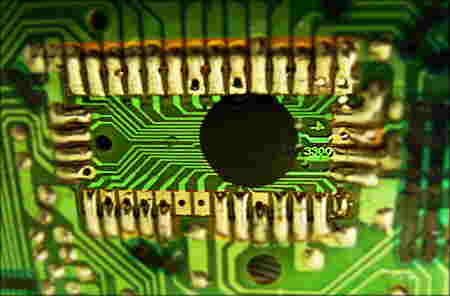 |
 |
 |
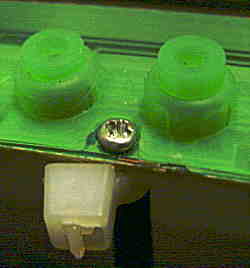 |
 |
warning: Regarding that this keyboard is mains operated, the wacky case construction with tiny transformer and cable mess inside rises the bad feeling whether you really should play it without a fire extinguisher next to it. At least I strongly recommend not to leave this tablehooter unattended and keep it away from romping children when plugged into the mains socket.
The preset sound list has some Engrish misspellings. Unlike Yongmei DL-2300, the operating concept of the control panel has some severe software bugs, those behave much like the user interface of certain poorly programmed Chinese toy keyboards. E.g. all buttons play a blip sound (when no notes are held), which disturbs live play, and the LED display is here pretty useless, because after 3 seconds it always returns to the tempo setting instead of showing the currently selected preset sound or rhythm number. (Pressing "timbre" e.g. only displays the word "ton" and then returns to the current tempo number until a new preset sound number is typed in. Only stepping the value with the +/- button shows it.) Starting any rhythm even always resets the tempo to 120BPM, which makes the overzealous tempo display completely meaningless; on a toy keyboard this would be barely tolerable, but for a (wannabe) real instrument this bug is far beyond acceptability. Also the rhythm programming mode immediately deletes the programmed rhythm when stopped, and the pattern is very restricted by the lack of pause steps. Why makes Yongmei such crap?! With only tiny changes this could have become a quite well usable and not too bad sounding keyboard. Generally the user interface bugs and case shape (but not sound) have similarities with the midsize toy keyboard Yongmei YM-238C; possibly both were programmed by the same designer.
Most main voice preset sounds are made from static natural waveforms and few simple volume envelopes; they sound not really realistic but nicely warm; despite digital hardware they have a classic analogue home organ appeal; many resemble filtered squarewave and remind to C64 sounds. Only "Acoustic Grand Piano" (with that the instrument powers on) employs medium resolution loop samples with at least 2 key split zones; it even sounds fairly natural despite loop point. But the programmer of this thing must have been on drugs or dyslexic, since even within the limits of the sound hardware many sounds are totally different from what their names suggest; e.g. all "Whistle" sounds decay like a picked string. Each waveform is likely made from 2 layered basic waveforms (similar like Bontempi KS 4600?), because many timbres sound similar but not identical. Their bit resolution is a bit low, which adds bassy noise to the bass range. The envelopes seem to be linear (not realistic) with little zipper noise and they are extremely simple; I am not sure if they are attack- decay or even only decay, because the attack is always extremely fast and clicks; only the click timbre differs among preset sounds by barely audible smacking noises. Unusual is that the clicking attack phase also varies its click intensity among notes, which makes the sound more vivid and reminds to Hammond organ key click. While the decay phase has a few (about 3) different speeds, the release time (after key release) is quite short and always the same. But don't worry - the envelopes of typical analogue home organs were also rarely more versatile, and in spite of this they could sound great. The only special envelope feature is mandolin ring in some preset sounds, which rings very fast (about 10Hz) and (like Yongmei YM-2100) all polyphony channels seem to be processed by a single LFO, since they always ring in the same phase. The preset sounds contain neither vibrato nor other pitch effects. Some preset sounds are identical or only barely differ in the attack click noise; I have listed these separately.
"Electric Grand Piano" is a dull e-piano that sounds like filtered squarewave. "Celesta" has the same envelope with a semi- metallic timbre, that turns buzzy in the bass range (like consonant- vowel synthesis - see Casio CT-410V); "Music Box" is similar in less harsh. "Acoustic Guitar 1" is a bit too bright with higher notes and thus a bit harpsichord- like; 2 is even brighter. "Bass" attempts to be a picked e-bass, but resembles more an e-piano. All sustaining tones have the same e-organ envelope with clicking attack and a tiny dose of sustain, which sounds like an analogue home organ; with bowed and blown instruments this attack sounds very unnatural. The "Violin" timbre is barely realistic in the mids and turns duller in the bass range. "Cello" is the same but thinner(!); its hollower bass range resembles a saxophone. "String Ensemble" is a duller "Violin" version. "Harp" is another very dull wannabe picked string that resembles an e-piano (but envelope is shorter). "Trumpet" is another envelopeless e-organ tone with semi- realistic brassy timbre (dull bass range resembles a tuba or french horn); "Tuba" is brighter and a bit thinner, while "French Horn" is the same in much duller (too dull). "Oboe" has that envelope with a semi- realistic timbre and sonorous bass range. "Clarinet" has a very dull analogue organ timbre, that is too dull to sound realistic. "Flute" has a metal flute timbre. "Banjo" has a too bright timbre (more a harpsichord) but turns too dull in the bass range (not sonorous enough). "Vibraphone" sounds fairly ok (no vibrato) although the linear envelope ends too soon. "Marimba" is only remotely natural in the mids; high notes are too harsh and the bass range is hollow (resembling sonorous multipulse squarewave). "Xylophone" is not realistic at all, but a very thin and harsh harpsichord timbre. "Bell" is another metallic e-piano. "Organ" sounds thin and could be rather a violin; "Accordion" is similar in hollower with sonorous buzzing bass range. "Jass Guitar" sounds like a (fairly harsh) banjo. "Synth Bass" is another dull e-bass. "Brass" is a duller and very unrealistic "Tuba" variant (like a narrow squarewave), "Alto Sax" a very thin saxophone timbre. All "Whistle" sounds decay and thus have nothing to do with a whistle. "Whistle" sounds like a very dull sine wave e-piano. "Lead" resembles a thin saxophone (intends to be a distorted feedback e-guitar?). "Bagpipe" sounds like a metal pipe organ rank. The "Mandolin" sounds thin and rings with 10Hz. "Acoustic Grand Piano1" resembles a clavichord or duller harpsichord, 2 resembles a nylon guitar or dull e-piano and 3 even has a brassy timbre (bass range resembles a tuba). "Electric Grand Piano1" has a shorter envelope and bright semi- metallic timbre (bass range slightly reminds to a slap bass), while 2 has a very short envelope and resembles a muted acoustic guitar. "Celesta 1" has the same envelope and sounds like a xylophone, while 2 is a semi- metallic e-piano or dull musicbox timbre with dull bass range. "Music Box 1" sounds a little glassy; mids resemble ceramic vessels and the bass is dull; 2 resembles rather an acoustic steel string guitar with dull bass range. "Acoustic Guitar(nylon)1" is too harsh and thin (timbre resembles harpsichord); 2 is hollower, has buzzy bass and resembles a banjo. "Acoustic Guitar(steel)1" is duller (like a filtered e-guitar?), while 2 is harsh and very thin. "Bass1" has a saxophone- like timbre and may be a distorted e-bass, while 2 has a decaying metal pipe organ timbre. "Violin2" has a buzzy semi- metallic pipe organ timbre; 3 may be a dull violin timbre. "Cello1" resembles a dull metal pipe organ rank; bass range is dull and buzzy; 2 resembles a bowed glass. "Harp1" is fairly bright with buzzy bass range (rather a steel string guitar?); 2 is duller. "Tuba1" resembles a pipe organ timbre; 2 is similar in duller. "French Horn1" resembles an oboe, 2 a Hammond organ timbre (waveform like a vibraphone). "Oboe1" resembles rather a harsh metal pipe organ rank with sonorous buzzing bass range; 2 is much thinner. "Clarinet1" resembles a bassoon or bright wood pipe organ rank; high notes sound like a bagpipe; 2 is brighter. "Flute 2" sounds like a dull wooden pipe organ rank. "Banjo1" sounds more like a clavinet. "Vibraphone 1" resembles more an acoustic guitar or e-piano; 2 is brassy (like "Acoustic Grand Piano3" with shorter envelope) and "Marimba1" is the same with very slightly brighter timbre. "Marimba2" is another brassy dull e-piano. "Xylophone1" has a metal pipe organ waveform (like "Bass2" with shorter envelope). "Accordian1" resembles rather a very nasal oboe (banjo timbre) with sonorous bass range. "Jass Guitar2" is a dull acoustic guitar with short envelope. "Mandolin1" to 3 ring like "Mandolin" with different waveform; 1 is dull, 2 glassy and 3 bright.
doublets (identical sounds):
| 04 | Acoustic Guitar 1 | = #83 Jass Guitar1 | |
| 07 | Violin | = #78 Organ1 | |
| 08 | Cello | = #47 Violin1, #95 Bagpipe1 | |
| 09 | Harp | = #86 Synth Bass2 | |
| 11 | Trumpet | = #79 Organ2, #90 Alto Sax2, #93 Lead1 | |
| 12 | Tuba | = #89 Alto Sax1, #94 Lead2 | |
| 13 | French Horn | = #87 Brass1 | |
| 17 | Banjo | = #75 Xylophone2 | |
| 18 | Vibraphone | = #85 Synth Bass1 | |
| 23 | Accordion | = #54 String Ensemble1, #56 Trumpet1 | |
| 26 | Brass | = #55 String Ensemble2, #57 Trumpet2 | |
| 32 | Acoustic Grand Piano1 | = #69 Banjo2, #77 Bell2 | |
| 50 | Cello1 | = #88 Brass2 | |
| 51 | Cello2 | = #66 Flute1 | |
| 60 | French Horn1 | = #80 Organ3 | |
| 67 | Flute2 | = #82 Accordian2, #96 Bagpipe2 | |
| 68 | Banjo1 | = #76 Bell1 | |
| 71 | Vibraphone2 | = #91 Whistle1 | |
| 72 | Marimba1 | = #92 Whistle2 |
Some of these have slightly different clicking attack phases, thus unlike Yongmei DL-2300 they are not exactly identical, but the change is barely audible and was likely rather a bug than intentionally programmed this way. Perhaps originally some sounds were designed to have a chorus effect (like with Yongmei YM-2100), which was later eliminated to increase polyphony. Likely there are still some doublets I haven't found, because there are only few envelopes and the waveforms have many gradual variants, thus finding identical preset sounds is like comparing Hammond organ drawbar settings by ear.
The vibrato button adds a 6Hz vibrato and the sustain button <1 second sustain. The "echo" button adds a kind of 6Hz slow mandolin ring to the sound of held notes (not to the release phase) and makes held notes decay within 2 seconds; unlike the normal mandolin ring, this one has individual trigger LFOs per channel, which permits interesting ring phase changes when multiple keys are pressed with some delay. While selecting preset sounds only affects new notes, the effect buttons also affect held notes, which can be used for live play tricks. Especially the echo button makes held notes decay only so long it is enabled, thus switching it off again keeps them at their reduced volume, which can be used as a sound effect. Like with Yongmei DL-2300 the effect buttons also affect the chord voice of accompaniment or manual bass.
The percussion is made from medium low resolution samples; hissing timbres have an special rough and impulsive appeal that reminds to POKEY noises - with their compact envelope they somewhat resemble the famous woody knocking Casio sample percussion (known e.g. from CZ-230S or MT-520), although the timbre is different. The 10 percussion sounds can be played in keyboard drumkit mode, and 6 of them are also accessible through 6 drumpad buttons. Annoying is that drumpad presses stop held notes immediately. The "tambourin" is the typical "Jingle Bells" xmess sleigh bell sound. Some icons are wrong; the tom drum icon on drumpads play the snare and on keyboard percussion the rimshot (or woodblock?).
The accompaniments are nicely arranged and groove not bad; some have a driving piano bass line. Unfortunately they are over- orchestrated (less versatile), there are only 10 preset rhythms (first digit of the 100 rhythm numbers is ignored) and like various other modern keyboards the fingered accompaniment recognizes only standard establishment chords and ignores other key presses. (Yongmei YM-2100 and DL-2300 did this much better.) During fill-in the accompaniment pattern continues. With rhythm off and fingered or single finger chord mode enabled, there is only a simple key split with a fixed electronic organ timbre (same like "String Ensemble") in the chord section. The organ can be played polyphonic, has percussive attack and a bassy timbre that reminds to a dull piano or e-bass (but doesn't decay).
To program a rhythm, press "program" and enter percussion with drumpads or in keyboard drumkit mode (only monophonic). Pauses can not be entered, despite the manual falsely claims that note keys would add them (which works on Yongmei DL-2300). Press "play" to finish, which immediately starts the programmed rhythm. Annoying is that the running user pattern can not be stopped without deleting it, and also neither accompaniment nor fill-in can be combined with it. The only thing you can do is pressing "play", which immediately restarts the running user pattern from beginning, which can be used as a sound effect.
The demo melodies are complex orchestrated and nicely made. Despite 4 of them are Chinese, they have a harmonious easy listening style with nicely warm accompaniment.
The 5 demo melodies are:
A very close successor of the YM-3300 came out as C. Aemon MK-2063.
I had the occasion to try one out in a 'Real' shopping center (retail
price 49€). It has a similar case with more stylish control panel
(silver and blue, but no analogue volume knob) and also the display behaves
similar. Nice is that the keys (at least of the tested specimen) feel less
wacky and make no polyphony flaws (polyphony is about 10 notes), and the
fingered chord and accompaniment now even accept random note combinations
and not only boring establishment chords. Unlike YM-3300 all preset sounds
of it are made from samples (strongly resembling Yongmei
DL-2300?); the manual chord mode employs a string sample. There
are 8 demos with accompaniment those each are a short melody loop that
cycles through multiple preset sounds. The accompaniment patterns are nicely
complex, but very annoying is that also this tablehooter has still many
fraudulent doublets in the preset sound and rhythm list, thus instead of
the claimed 100 there are only roughly about 20 or 30 individual preset
sounds and rhythms. And like with my YM-3300 also the poisonous chemical
odour and flimsy plastic are still present, and the German language box
particularly advertises the presence of 2 tweeters, those are genuinely
fake props. Apparently an 61 key variant of the YM-3300 was released by
Ouda as MQ6148 and in silver as MQ6138 (different
sound list, seen on eBay).
| removal of these screws voids warranty... | ||
 |
||
|
|